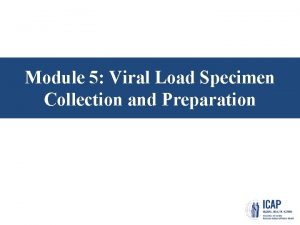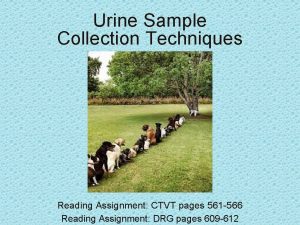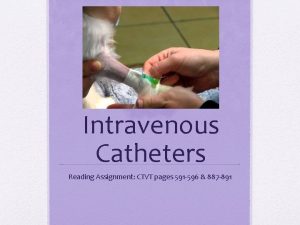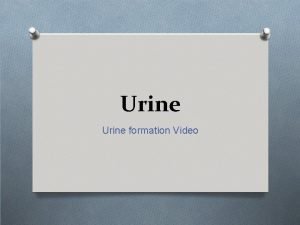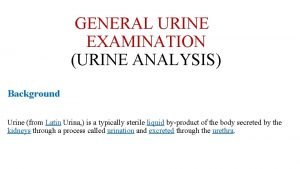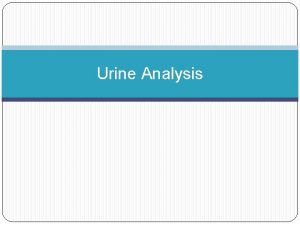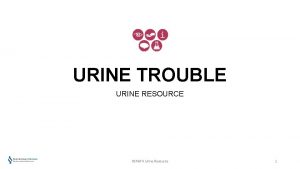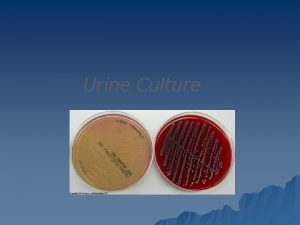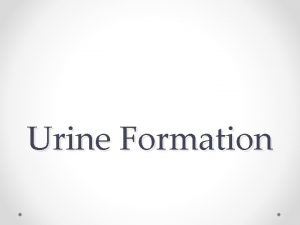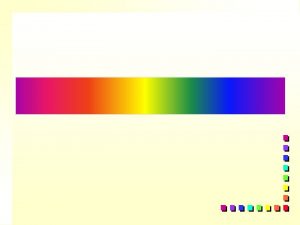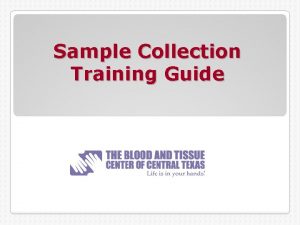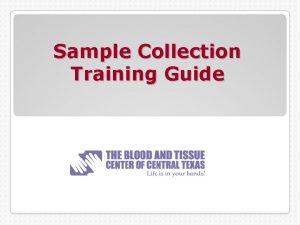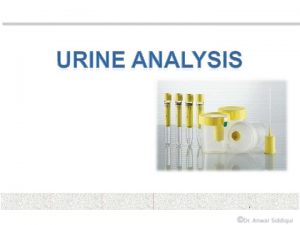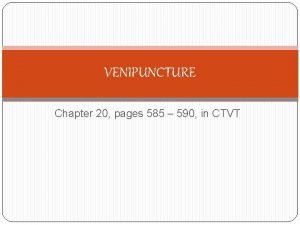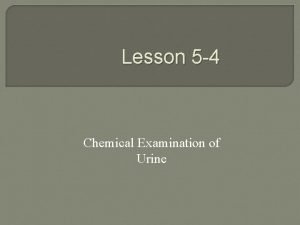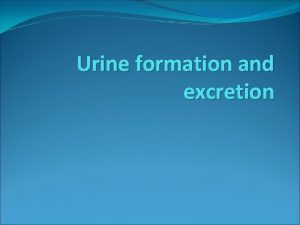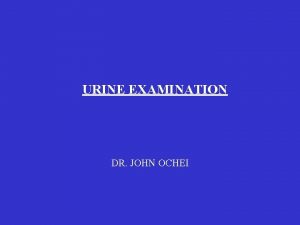Urine Sample Collection Techniques Reading Assignment CTVT pages



































- Slides: 35

Urine Sample Collection Techniques Reading Assignment: CTVT pages 561 -566

Objectives Understand the different urine collection techniques and when each is preferred Understand the procedure for performing a cystocentesis Understand the risks and possible complications associated with cystocentesis Understand the procedure of urinary catheterization and associated complications Skills: Demonstrate proper technique for a cystocentesis Understand how to place a urinary catheter in male dogs and cats

Indications for Urine Collection Why would a veterinarian request a urinalysis? Concern with ______ or ______: Examples: • Urolithiasis • Bacterial infection • Disease (ex. FLUTD, FIC, blocked tom, pyelonephritis) • Diabetes • Dehydration

Anatomy Review Urine accumulates in the bladder: we need to understand anatomy, to understand how to get to our goal. Where is the bladder is located? What is the bladder made of?

Abdominal Anatomy

Collection Techniques Cystocentesis Manual expression Voided via free catch Urinary catheter

Cystocentesis Definition: Indications:

Cystocentesis Contraindications:

Cystocentesis Advantages: Sample is free from all contaminations/disease in lower urinary tract Considered the most _______ form of urine collection Quick, minimal supplies Minimizes ______ UTI or trauma to _____

Cystocentesis Complications: Bruising of tissue Iatrogenic ______ Possible laceration of bladder Trauma/laceration of other anatomy

Cystocentesis Gather your supplies Dog: Cat:

Cystocentesis Positioning Dog: Restraint: Cat: Restraint

Internal Bladder Anatomy

Bladder Location 1. Palpation

Bladder Location 2. Canine landmarks

Bladder Location 3. Machines

Cystocentesis Procedure 1. Locate bladder and use non-dominant hand to isolate • Stabilize in a _______ direction 2. Wet injection site with ____________ 3. Hold syringe so you can aspirate w/o changing position 4. Place needle directly into bladder, with intent, between a ______ angle. Angle needle in a _______ direction Length of needle will determine depth into patient Communicate with restrainer before poking!

Cystocentesis Procedure Ventral approach notes: • • • Poke on _____________ Move penis/prepuce laterally Avoid abdominal blood vessels 5. Use aspiration to withdraw desired amount of urine. *Where should you be looking? 6. Stop aspirating! Why is this important? 7. Bring needle straight out

Cystocentesis Troubleshooting If you aspirate blood in your needle: Abort mission, come straight out Change needle and syringe and try again If you get negative pressure: May go deeper into animal BUT must first release pressure from aspiration Aspirate again If no urine: ____________ & bring needle straight out

Urine Storage Urine is transferred to a ______ specimen cup or ____ Urine must be transferred directly through the rubber top of the tube Should be tightly sealed to prevent contamination or evaporation Urine must be analyzed within __________ of collection If not:

Additional Notes Reading Assignment: DRG pages 609 -612 Lab notes: Every student will perform at least one cystocentesis. You do not have to actually collect urine to be successful on this skill; we will be watching your preparation and technique. Charting: Sign the animal out under Classroom Use Record successful or unsuccessful here Any amount of urine in syringe is successful

Manual Expression IF we used this for diagnostic testing: Indications: Contraindications:

Manual Expression Advantages: Disadvantages: Complications that could happen:

Voided/Free Catch Indication: Gather your supplies Dog: Cat: Advantages: Disadvantages:

Urinary Catheterization Definition: Contraindications:

Urinary Catheterization Indications:

Types of Urinary Catheters

Urinary Catheterization Male dog: The technically-easiest patient 1. Aseptic technique: Prepuce hair must be clipped Flush prepuce with ________________ Rinse with warm water or sterile saline 2. Don sterile gloves 3. Handle catheter ________ at all times 4. Apply ______ lubrication • Local anesthetic gel available

Urinary Catheterization Male dog continued: 4. Restrainer will retract prepuce to expose penis 5. Advance catheter through tip of penis, into urethra Continue until urine is seen 6. Aspirate urine, with _____ syringe or secure catheter in place Use white tape and at least two ______ sutures Note: If collecting urine for testing:

Urinary Catheterization Female Dog: • Extra supplies may be needed: o If not available, use blind technique

Urinary Catheterization Female Dog: • Clip any fur around vulva • Wash with dilute antiseptic; rinse • Insert speculum • Visualize urethral opening 2 -4 cm inside vagina on the ventral floor • Insert catheter until urine is observed • Secure by taping catheter to tail or placing stay sutures

Urinary Catheterization Male cat: Most common indication = _____________ Sedation or anesthesia likely Hind limbs should be pulled _____ Aseptically prep site as normal Extrude the penis evaluate tip for a urethral plug Advance tomcat or polypropylene catheter into urethra Use sterile ____ to push blockage if necessary Secure with stay sutures

Monitoring Output A closed system can be created by attaching the catheter to an IV line and then a sterile collection bag. Patients that are NORMOTENSIVE, NORMOVOLEMIC, and have adequate renal functions should produce ________ of urine.

U. Catheter Maintenance Urinary catheters should be removed ASAP o Reduce inflammation an potential for infection Replace indwelling urinary catheters every ________

Urinary Catheterization Complications from receiving a urinary catheter:
 Printed pages vs web pages
Printed pages vs web pages Dari hasil tes urine ternyata urine
Dari hasil tes urine ternyata urine Website is a collection of : *
Website is a collection of : * Nurses responsibility in collection of urine specimen
Nurses responsibility in collection of urine specimen Pre reading while reading and post reading activities
Pre reading while reading and post reading activities Landsat collection 1 vs collection 2
Landsat collection 1 vs collection 2 Documentary payment
Documentary payment Instrument for research data collection
Instrument for research data collection Projective techniques of data collection
Projective techniques of data collection Cevrelo
Cevrelo Hemolyzed serum sample
Hemolyzed serum sample Hemolyzed serum sample
Hemolyzed serum sample What is the climax in a sound of thunder
What is the climax in a sound of thunder Les fonctions techniques et les solutions techniques
Les fonctions techniques et les solutions techniques Reading techniques
Reading techniques What is scaning
What is scaning What is reading and types of reading
What is reading and types of reading What is intensive reading
What is intensive reading A poem a.skimming b.scanning c.extensive d.intensive
A poem a.skimming b.scanning c.extensive d.intensive Representative population
Representative population Quota sampling qualitative research
Quota sampling qualitative research Volunteer sample vs convenience sample
Volunteer sample vs convenience sample Cluster sampling
Cluster sampling Stratified sample vs cluster sample
Stratified sample vs cluster sample Uji t untuk satu sampel
Uji t untuk satu sampel When does the ncsbn begin the next generation nclex
When does the ncsbn begin the next generation nclex Gort-5 descriptive terms
Gort-5 descriptive terms Sample of collateral reading
Sample of collateral reading Round robin reading vs popcorn reading
Round robin reading vs popcorn reading Aims and objectives of teaching
Aims and objectives of teaching Definition of guided reading
Definition of guided reading Involves scrutinizing any information that you read or hear
Involves scrutinizing any information that you read or hear Real definition of extensive reading
Real definition of extensive reading Intensive and extensive reading
Intensive and extensive reading Dominant rules
Dominant rules The lorax story is often called a cautionary tale
The lorax story is often called a cautionary tale











